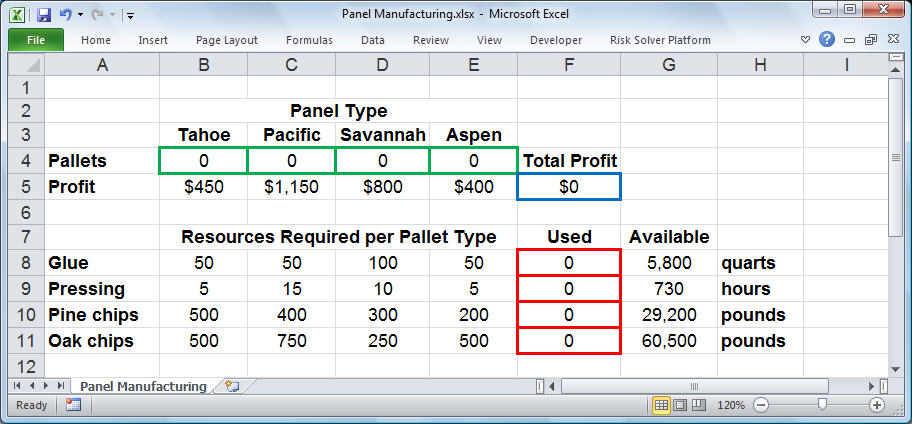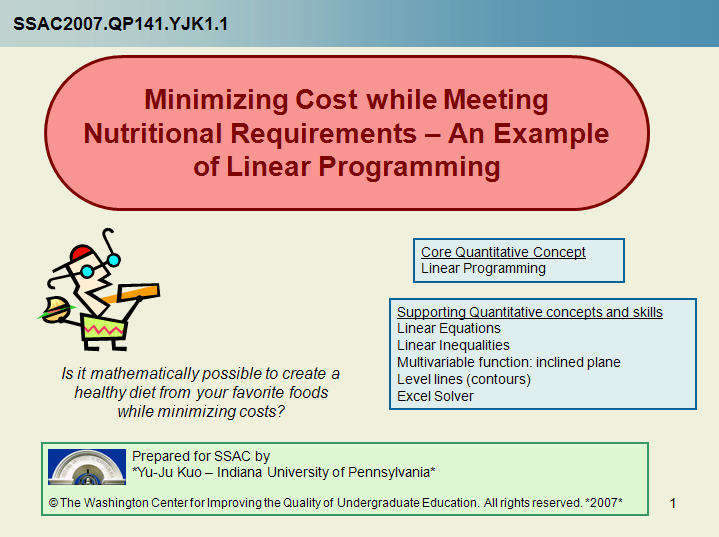

#Excel frontline solver linear programming example code#
More help on using Solverįor more detailed help on Solver contact:Į-mail: Help at Portions of the Solver program code are copyright 1990-2009 by Frontline Systems, Inc. If you have the Excel desktop application, you can use the Open in Excel button to open your workbook to use the Solver add-in. On the =, in the Constraint box, type a number, a cell reference or name, or a formula.īecause add-in programs aren’t supported in Excel for the web, you won’t be able to use the Solver add-in to run what-if analysis on your data to help you find optimal solutions. In the Subject to the Constraints box, add any constraints that you want to apply. You can specify up to 200 variable cells. The variable cells must be related directly or indirectly to the objective cell. Separate the nonadjacent references with commas. In the By Changing Variable Cells box, enter a name or reference for each decision variable cell range. Set the objective cell to a certain valueĬlick Value Of, and then type the value in the box. Make the value of the objective cell as small as possible Make the value of the objective cell as large as possible Note: The objective cell must contain a formula. To save your decision variable cell values as a scenario that you can display later, click Save Scenario in the Solver Results dialog box, and then type a name for the scenario in the Scenario Name box. If Solver doesn't find a solution, only certain reports or no reports are available. The report is created on a new worksheet in your workbook. To create a report that is based on your solution after Solver finds a solution, you can click a report type in the Reports box and then click OK.

Excel recalculates the worksheet with the last values that are found for the decision variable cells. You can interrupt the solution process by pressing Esc. To restore the original values before you clicked Solve, click Restore Original Values. To keep the solution values on the worksheet, in the Solver Results dialog box, click Keep Solver Solution. In the Solver Parameters dialog box, click the constraint that you want to change or delete.Ĭlick Change and then make your changes, or click Delete. You can change or delete an existing constraint by doing the following: Note You can apply the int, bin, and dif relationships only in constraints on decision variable cells. To accept the constraint and return to the Solver Parameters dialog box, click OK.

To accept the constraint and add another, click Add. If you choose = for the relationship in the Constraint box, type a number, a cell reference or name, or a formula. If you click dif, alldifferent appears in the Constraint box. If you click bin, binary appears in the Constraint box. In the Cell Reference box, enter the cell reference or name of the cell range for which you want to constrain the value.Ĭlick the relationship ( =, int, bin, or dif ) that you want between the referenced cell and the constraint.If you click int, integer appears in the Constraint box. In the Solver Parameters dialog box, click Add. In the Subject to the Constraints box, enter any constraints that you want to apply by doing the following: Separate the non-adjacent references with commas. If you want the objective cell to be a certain value, click Value of, and then type the value in the box. If you want the value of the objective cell to be as small as possible, click Min. If you want the value of the objective cell to be as large as possible, click Max. The objective cell must contain a formula. In the Set Objective box, enter a cell reference or name for the objective cell. Note: If the Solver command or the Analysis group is not available, you need to activate the Solver add-in.


 0 kommentar(er)
0 kommentar(er)
